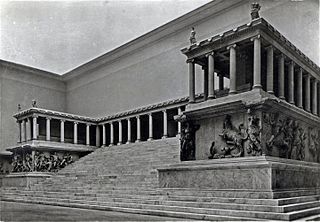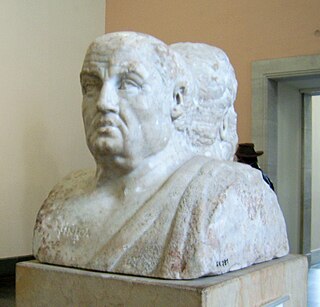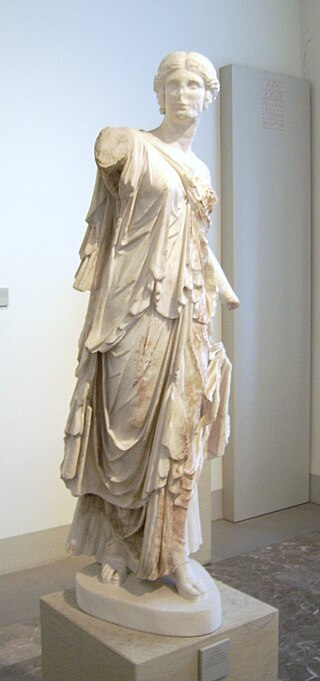
The Fragment from the tomb of Nikarete [1] from the third quarter of the fourth century BC, found near Athens is displayed today in the Antikensammlung of the Altes Museum in Berlin.

The Fragment from the tomb of Nikarete [1] from the third quarter of the fourth century BC, found near Athens is displayed today in the Antikensammlung of the Altes Museum in Berlin.
The 117 cm high and 59 cm wide fragment of a grave relief made out of Pentelic marble depicts a woman named Nikarete, daughter of Ktesikles of the deme of Hagnous. Her name is preserved on a piece of the grave's gable, which was separately manufactured. Nikarete belongs to the same type of scene as the Grave relief of Thraseas and Euandria, sitting at the right hand side of the relief, looking left. She sits on a backless, cushioned stool. Her head projects from the relief and faces forward. She wears a cloak (himation) over her head. Under this she wears a chiton with flaps and buttoned sleeves. Nikarete's hair is unparted, gathered up into a knot above her forehead. There are holes in her earlobes which once contained real earrings.
It is not clear how large the complete relief was or how many other people were depicted in it. It probably belonged to one of the most elaborate grave monuments of the fourth century BC, some of which are known today. Such monuments were mostly erected by the economically successful members of the Athenian citizenry. The nose, part of the lips and the greater part of the cloak are entirely modern reconstruction, carried out in the workshop of Johann Gottfried Schadow.
The fragments were found between Athens and the port of Piraeus. The pieces were acquired by the Baron Albert von Sack [2] who traveled through Greece and the east with Georg Christian Gropius, then the Austrian consul in Athens and acquired a collection of ancient artefacts in the process which he later sold to the Antikensammlung in Berlin. It was one of the first ancient artworks to come to Berlin without passing through the Italian art trade.

The Pergamon Altar was a monumental construction built during the reign of the Ancient Greek King Eumenes II in the first half of the 2nd century BC on one of the terraces of the acropolis of Pergamon in Asia Minor.

The Altes Museum is a listed building on the Museum Island in the historic centre of Berlin, Germany. Built between 1825 and 1830 by order of King Frederick William III of Prussia according to plans by Karl Friedrich Schinkel, it is considered a major work of German Neoclassical architecture. It is surrounded by the Berlin Cathedral to the east, the Berlin Palace to the south and the Zeughaus to the west. Currently, the Altes Museum houses the Antikensammlung and parts of the Münzkabinett. As part of the Museum Island complex, the Altes Museum was listed as a UNESCO World Heritage Site in 1999, in recognition of its testimony to the development of the museum as a social and architectural phenomenon.
The Antikensammlung Berlin is one of the most important collections of classical art in the world, now held in the Altes Museum and Pergamon Museum in Berlin, Germany. It contains thousands of ancient archaeological artefacts from the ancient Greek, Roman, Etruscan and Cypriot civilizations. Its main attraction is the Pergamon Altar and Greek and Roman architectural elements from Priene, Magnesia, Baalbek and Falerii. In addition, the collection includes a large number of ancient sculptures, vases, terracottas, bronzes, sarcophagi, engraved gems and metalwork.

The oinochoe by the Shuvalov Painter in the collection of Antikensammlung Berlin is an erotic depiction from ancient Greek vase painting.

The Berlin Foundry Cup is a red-figure kylix from the early 5th century BC. It is the name vase of the Attic vase painter known conventionally as the Foundry Painter. Its most striking feature is the exterior depiction of activities in an Athenian bronze workshop or foundry. It is an important source on ancient Greek metal-working technology.

Etruscan vase painting was produced from the 7th through the 4th centuries BC, and is a major element in Etruscan art. It was strongly influenced by Greek vase painting, and followed the main trends in style over the period. Besides being producers in their own right, the Etruscans were the main export market for Greek pottery outside Greece, and some Greek painters probably moved to Etruria, where richly decorated vases were a standard element of grave inventories.

The Double Herm of Socrates and Seneca is an ancient Roman statue from the first half of the third century AD. The herm depicts the Greek philosopher Socrates on one side, and the Roman Stoic Seneca the Younger on the other. It currently belongs to the Antikensammlung Berlin, found in the Altes Museum.

The Attic Grave relief of Thraseas and Euandria from the middle of the fourth century BC is kept in the Pergamonmuseum and belongs to the Antikensammlung Berlin.
The Neck Amphora by Exekias is a neck amphora in the black figure style by the Attic vase painter and potter Exekias. It is found in the possession of the Antikensammlung Berlin under the inventory number F 1720 and is on display in the Altes Museum. It depicts Herakles' battle with the Nemean lion on one side and the sons of Theseus on the other. The amphora could only be restored for the first time almost a hundred and fifty years after its original discovery due to negligence and political difficulties.

A Relief depicting a Roman legionary is located in the Pergamonmuseum and belongs to the Antikensammlung Berlin. The relief was created at the end of the first century AD and was discovered in 1800 at Pozzuoli.

The Grave relief of Publius Aiedius and Aiedia is an ancient Roman grave relief from the first half of the first century AD, now kept in the Pergamonmuseum / Antikensammlung Berlin, with Inventory number SK 840.
Irma Wehgartner is a German Classical archaeologist.
Elisabeth Rohde was a German classical archaeologist.

The Green Caesar is a portrait of Gaius Julius Caesar made of green slate kept in the Antikensammlung Berlin, which was likely made in the first century AD.

The statuette of hoplite found at Dodona is an archaeological find which was purchased in 1880 and is hosted today in Berlin at the Altes Museum

Dancer of Pergamon is the modern name for a Hellenistic statue of a woman from Pergamon, which is now kept at the Antikensammlung Berlin.
The Athena with cross-strapped aegis is an ancient statue of the Greek goddess Athena, which was made around AD 150 and is now displayed in the Antikensammlung Berlin.

The find complex associated with a group of ancient Apulian picture vases for a funeral ceremony consists of 29 vases, plates, vase fragments, and fragment groups, which are showpieces of the Berlin Collection of Classical Antiquities in the Altes Museum. The vase ensemble comprises vases of varying sizes and values, consistently decorated with images in the rich style of Apulian vase painting. Additionally, there are vases of medium and low quality. All the pieces likely originate from a looted excavation in the latter half of the 20th century.

The Nike Fixing her Sandal, also known as Nike Taking off her Sandal or Nike Sandalbinder, is an ancient marble relief depicting Nike, the ancient Greek goddess of victory, in the process of fixing or removing the sandal of her right foot. The late fifth-century BC sculpture is the remaining right part of a larger slab from a parapet, which originally adorned the Temple of Athena Nike on the Acropolis of Athens. It is now kept and exhibited in the Acropolis Museum of Athens, in Greece with inventory number 973.

The Calvatone Victoria is a gilt bronze statue from the Roman Imperial period. It belongs to the inventory of the Antikensammlung Berlin, but is now held in Hermitage Museum in Saint Petersberg.